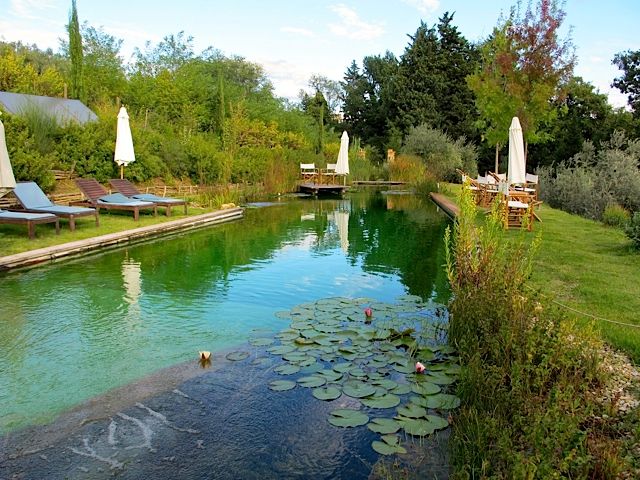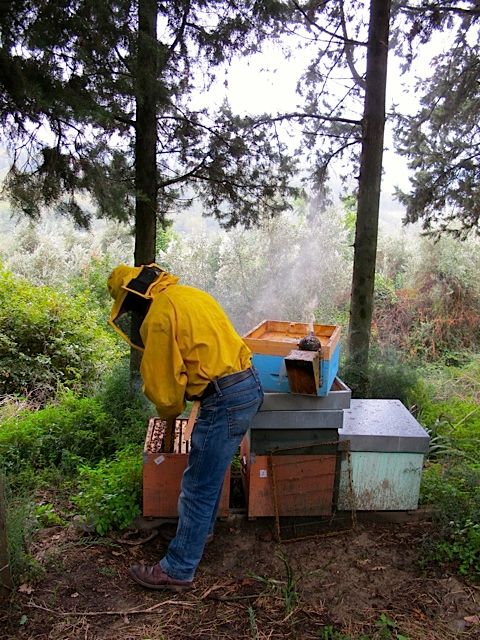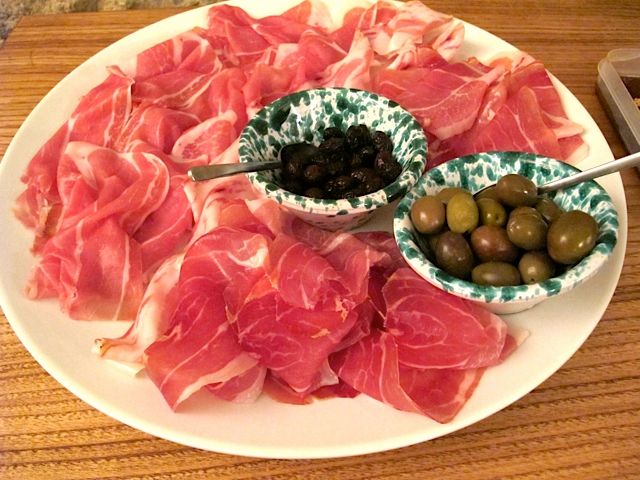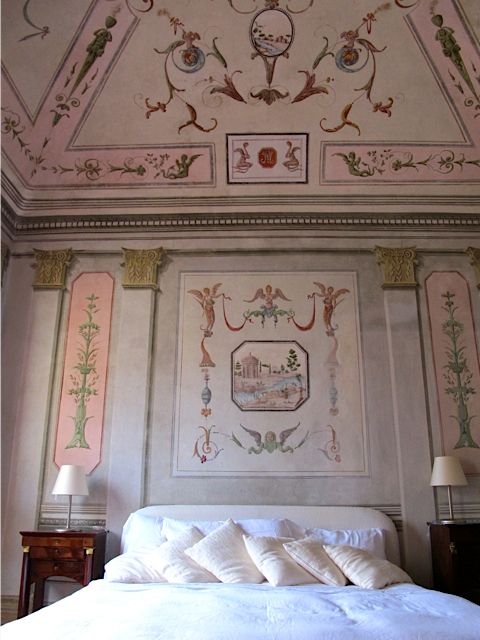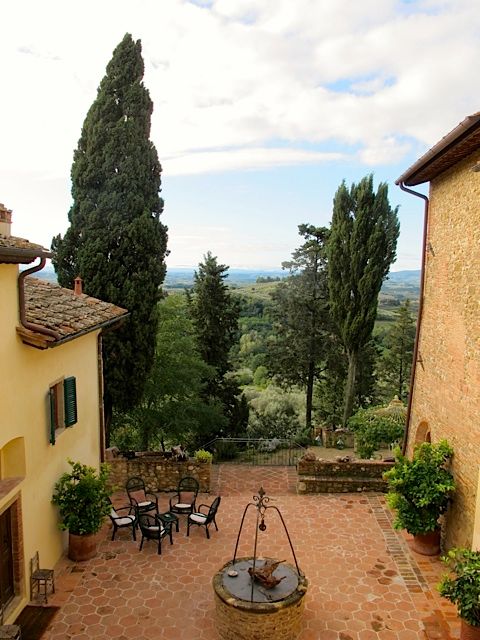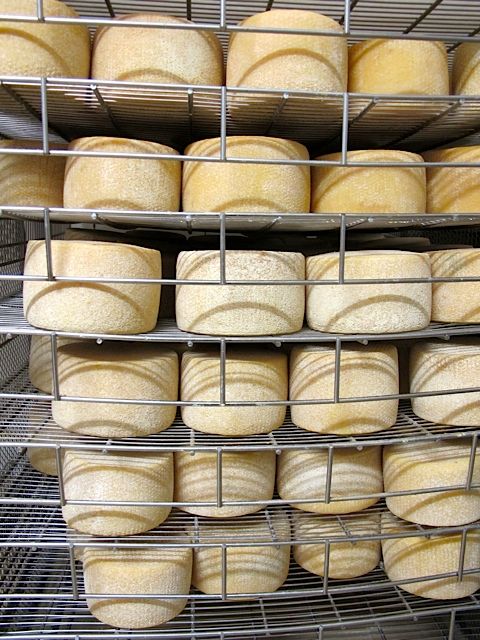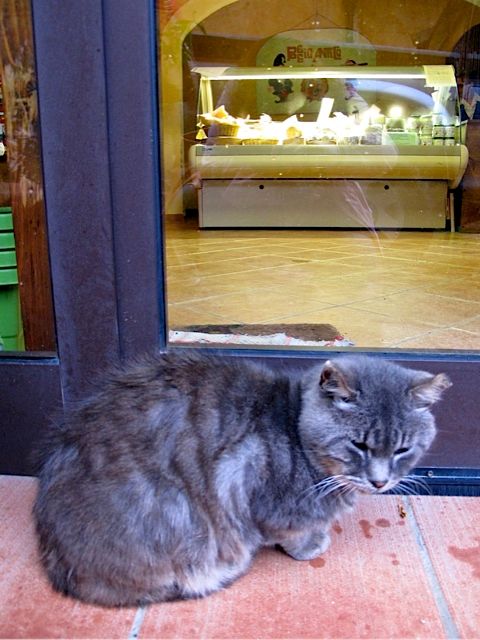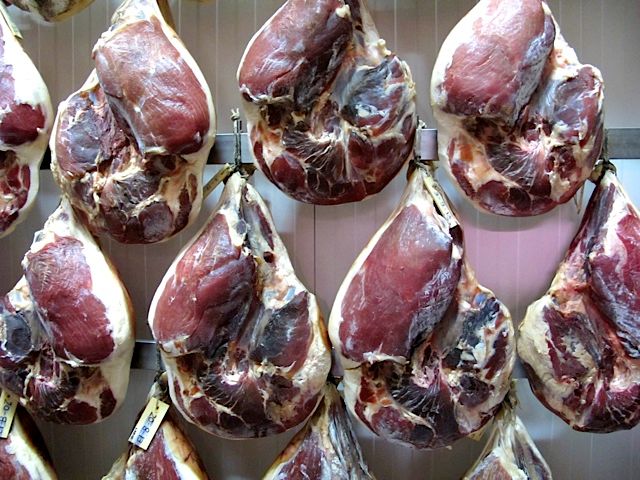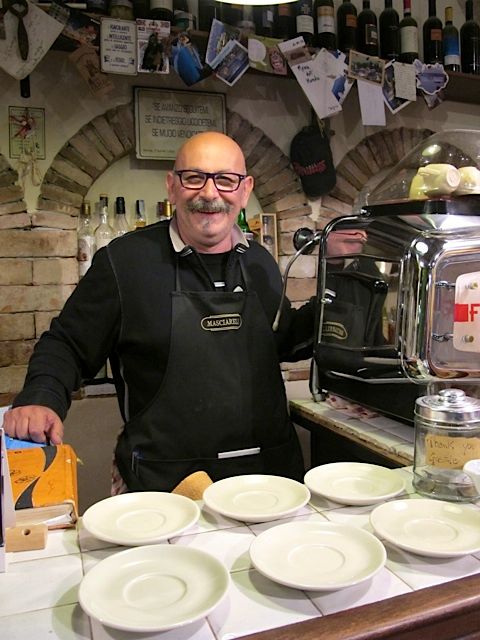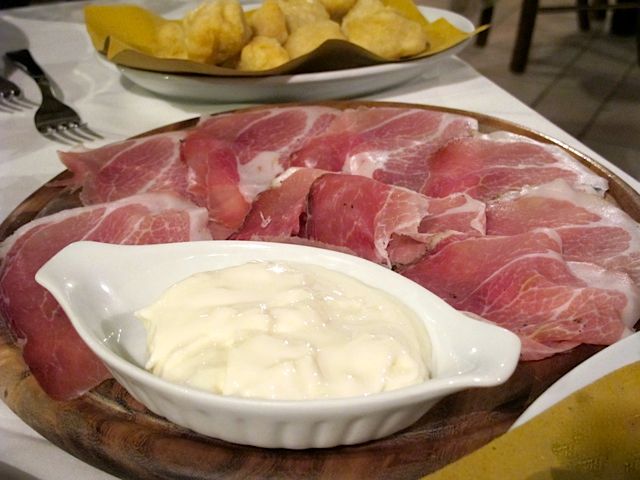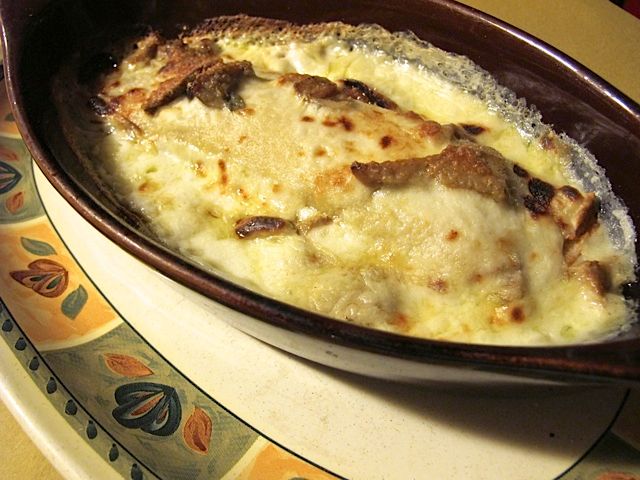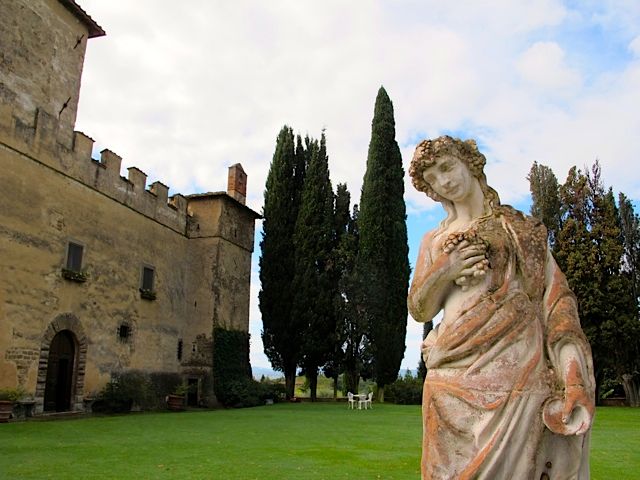You can view my entire photo album here.
Last October, after I finished a week with my father in Rome and visiting family in Calabria (pics here), we drove north together in our trusty Meriva. We were heading to our ultimately separate destinations: he was off toward Padova to visit his friend, Lucio Gomiero of Vignalta, while I was going to be staying for a few nights in Chianti. Earlier in the year, I was invited by the owners of Il Paluffo to come experience their stunning 15th-century property, and an abridged version of their specialized weeklong program for guests, Toscana Taste and Beauty.
In all my travels around Italy for the past 25 years, I had never visited Chianti, so the invitation was especially compelling for this sangiovese and finocchiona lover. The Paluffo property is located in a downright dreamy area—full of vineyards and olive groves—in Chianti Colli Fiorentini, in between the tiny villages of Fiano and Lucardo. The property is truly breathtaking: it includes a medieval tower house, a manor house with gorgeous frescoes from the 17th and 18th centuries (which is where you’ll find four bedrooms that you can stay in), an ancient olive mill, and I loved the creaking doors, terra-cotta floors, vintage key locks, and stone walls—the place has such presence. There are also four apartments you can stay in, good for four to six guests.
The owners, Liana Stiavelli (whose ancestors owned the property in the 18th century) and her husband, Luca Del Bo, finished painstakingly restoring the Paluffo property in 2010, and I respect the eco-conscious approach they took. They use renewable energy, like solar panels, and rainwater is collected for irrigation.
The bio pool is so unique—it’s a swimming pool filled with natural water instead of chlorinated water, and the surrounding plants filter the water. It’s like an extremely clean pond, and it killed me that I couldn’t hop in—it was the beginning of fall and the stormy weather was just too chilly. They also have their own beehives on the property, and one rainy afternoon, I was escorted to the hives to visit the bees (and pilfer a bit of honeycomb that we enjoyed later that evening for dessert).
You’ll meet their charming black cat, Ombra (“shadow”), who fittingly slinks around the property, and if you don’t pay attention, you may accidentally discover him like I did when I leaned back into the pillows one evening on the communal couch—he was asleep in between the pillows. We both jumped. And then he hopped into my lap. Meow.
After the long drive north from Calabria (and of course getting lost, Google maps is not infallible), my father and I were tired and hungry (and someone was a little cranky too). Liana and Luca had a gorgeous spread waiting for us with different kinds of local prosciutto and guanciale, finocchiona (I was blown away with the one they served), green and black olives, a caper spread, pizza from a local pizzamaker, young and aged pecorino, two kinds of marmalade, honey from the property’s beehives, and some wonderful wines (Liana is studying for a sommelier exam, so she can also make some good recommendations on wineries to visit in the area). Now that’s what I call a taste of Toscana.
It was quite the once-in-a-lifetime experience to sleep in my beautiful room, full of antique furnishings, captivating frescoes on every surface (I seriously felt like a contessa in the 1700s), and then to get woken up in the middle of the night with a dramatic lightning show and the loudest thunder just overhead. Crack BOOM! Nothing like a good lightning show in Italy, I swear.
I so enjoyed my view overlooking the courtyard, watching it change with the weather each day, with the fresh air coming through my windows. My bathroom was a few doors down the hall, but I didn’t mind—the massive marble sink basin and shower made me make a mental note for my future dream bathroom (I loved the balance of the modern and the ancient in the décor).
The next morning, after a breakfast of farm-fresh eggs with a chunk of bread (which I drizzled with the spicy Paluffo olive oil, of course), we got my dad off to the train to Padova (ciao Papa!), and then Liana brought me to Corzano + Paterno, a farm and agriturismo known for their Sardinian sheep’s milk cheeses, olive oil, and wine. You don’t find a lot of sheep in the area, so their offering is very unique.
Any guest of the Toscana Taste and Beauty program benefits from a customized experience; when Liana and Luca learned how much I adore cheese and salumi, they made arrangements to take me to truly artisanal places in the area. We had an appointment with the talented cheesemaker, Antonia Ballarin (known as Toni), who walked us through her cheesemaking process. She does a lot of experimentation, like grappa washes on the cheese, and she told me they use lardo to fill the holes on their Tegola cheese (cool), and one of their well-known pecorino cheeses, Buccia di Rospo (“frog skin”) came about because of a mistake (we love those).
They have quite a range of cheeses, from the creamy Marzolino to a truffled pecorino to the ashy Rocco, made like a goat’s cheese. Their aged (stagionato) pecorino was truly special (and gets spoken for and snapped up by the best restaurants and residents). It ends up their ricotta is pretty famous in the area, with people coming by around 2:30pm to have it warm and fresh (again, there’s some competition for it). There’s a tasting room where you can enjoy their wine and stellar cheeses, but meeting the vivacious Toni is what made the visit so memorable.
Next stop: the very under-the-radar Poggio Antico. This biodynamic farm raises cows and goats—the owners came from the Veneto about 30 years ago and wanted a change of life. They learned how to make cheese, and now only make raw milk cheeses with a vegetable rennet (based on its name being “Cynara cardunculus,” it’s in the thistle family: a cardoon).
The list of cheeses they produce is extensive, like a goat taleggio, their cow’s milk poggese (which is shaped like Asiago), their caprino fresco, which they learned to make from a Siena native. And then you have this unusual find: mozzarella in Tuscany! Unpasteurized mozzarella, I gotta tell you, it’s the stuff—it was so creamy that it looked like ice cream on my lunch plate later. Even their yogurt was transcendent. There are also a variety of pastas they make from ancient grains—you can pick up some locally made pici to bring home.
A highlight for me was our visit to Macelleria Parti in San Donato in Poggio, a medieval (and walled) city. The second generation is now in charge of this meat shop (founded in 1970). The son, Emiliano, took over in 1989, and he has been making salumi all his life. Literally: there are pictures of him as a young boy in a white coat cutting lardo, I kid you not.
We had a quick appointment for a behind-the-scenes tour of the back room and their production. It was a great opportunity for me to learn more about one of my very favorite salumi, finocchiona, and he let me taste the very tiny but pungent wild fennel seeds they use, crucial. I also learned a funny thing about the name: he said back in the day you would give someone fennel before drinking wine to help hide any wine defects—the term eventually was used to mean “to fool someone” (“infinocchiare”). Gotta love a good etymology lesson while you’re tasting salumi.
The heady smell of their curing room was just beyond, meaty and funky, and I got to taste their famous salame toscano, and an ancient one called bastardo/”mezzone” (it has a little bit of beef mixed in, about 8 percent!), and learned more about their epic lonzino, which is salted, washed, and covered with garlic, black pepper, peperoncino, and nutmeg—you can bet I brought home a big chunk of that one in my bag (had to keep the finocchiona company, you know). The salumi they make here have so much flavor—everything was really juicy and masterfully seasoned. I would drive miles just to be able to go back there again and buy up the entire case—you think I’m kidding?
We had a couple of dinners out that were on different sides of the spectrum, but both were very cozy and comfortable osterie. One rainy night we dined at Osteria dell’Ignorante in Lucardo, and I knew I was going to love the cheeky owner (Stefano Giuliacci) based on the sign on the front door telling people they only serve Tuscan food, so don’t ask for lasagna Bolognese or pasta with pesto. Amen! Priceless. (Be sure to get one of their business cards as well, you won’t be disappointed.)
It was a hearty and rustic meal, one that felt home-cooked and very personal. Totally a Tuscan meal, it tasted of place. Dishes would come out when they were ready, and the vibe was relaxed. Stefano is quite the host. He stuffed us with frittelle di baccalà (salt cod fritters), coccoli (fried dough) con prosciutto crudo and stracchino (one of my favorite fresh cheeses of all time), and we had an unusual pasta of strigoli with a sweeter sauce of figs with prosciutto. And then there’s the kicker: we had donkey with polenta. It was unexpectedly so very good—the tender meat reminded me of brisket, but sweeter. It’s the kind of place where you laugh, drink too much wine, and go home happy with a full belly. Of donkey.
The owner of L’Osteria di Casa Chianti in Fiano offered a different kind of hospitality—less jovial but so very thoughtful and detailed. Our meal had a touch more refinement, with dishes like quail eggs with shavings of the first white truffles, and a carpaccio of lonzino (I love the spice of this salume), with thin slices of porcini, arugula, lettuce, grana, and olive oil. Not a looker, but what a magic combination of flavors. The gnocchi with blue pecorino cheese and fresh figs were ethereal (again, fresh figs in pasta, huh!); the porcini crespelle were a bubbly and cheesy splurge; and of course I had to try their pici in a ragu made with Cinta Senese pork (it’s an ancient breed of Tuscan pig, famous for its white belt).
The owner had the kitchen prepare a tasting menu for us, something I highly recommend so you can taste more dishes. All night, the wine pairings were spot-on, all the way to a beautiful finish of vin santo gelato with crumbled cantuccini mixed in. I was smitten with everything about this place, well, except the high-watt lightbulbs that seared the back of my retina (Italy, what is UP with your bright lights?). And if you’re looking for bistecca alla fiorentina, based on all the steaks I saw on tables, this is a good place to do it—there is quite the grill in the kitchen.
Both osterie were proud to feature pasta made by Wilma of Pasta Fresca (in Tavarnelle Val di Pesa). It ends up she is a very famous local pasta maker who supplies a lot of restaurants around town, and was the very one who was going to teach us how to make pasta one night at Paluffo. It was an inspiring class: we learned so many different types we could actually make (she made it look so easy), and she made sure we all took turns kneading the dough, rolling it, and running it through the pasta machine.
I was so taken with her adorable combination of Italian and English all night—she reminded me of my Aunt Terry, who never quite spoke one or the other after living in the U.S. after 30 years. Wilma is a one-woman army, and showed us how to make garganelli, ravioli, farfalle, tortellini, little stuffed “pochettes,” and pasta alla chitarra, among other shapes. Of course at the end our class of seven got to enjoy the fruits of our labor, along with some local wines. Cin cin! (There are other cooking classes available through Toscana Taste and Beauty as well.)
Speaking of wines, it wouldn’t be a trip to Chianti without visiting a couple of wineries, hello. One winery we visited was Paneretta, which has a 400-year-old castle that will definitely take your breath away. The frescoes by Bernardino Poccetti—dating back to the late 1500s—are something to behold. It’s a traditional winery, all estate grown, that only uses local and handpicked grapes (sangiovese and they are very proud of their use of canaiolo), with winemaking records going back to 1596. We tasted four of their wines (the 2009 Chianti Classico Riserva was a favorite, full of cherry, aged for two years in their ancient casks and in barrique, and then blended).
Another winery we visited was Castello Monsanto (don’t let the name deter you, no relation), where we got to tour the vineyards with the vibrant Laura Bianchi and her two adorable dogs, Tico, a little white fluff who never stopped bouncing around her, and Nina the German shepherd.
Her father’s first vintage at Castello Monsanto was 1962, from the Il Poggio vineyard, and it was the first single vineyard bottled in Chianti Classico. Now Laura is overseeing the winery, working closely with winemaker Andrea Giovanni (previously at Ornellaia). The aging cellar is huge—we’re talking almost 1,000 feet long—and handmade with galestro stones. Laura said when it rains, the smell of the galestro stone matches the taste of graphite in the wine. It’s a huge estate, with olive groves, gardens, and an agriturismo as well.
We tasted some of their wines, starting with the 2011 Castello Monsanto chardonnay (30 percent fermented in oak; I loved the salinity in this wine), and I’m glad we got to try the 2009 Il Poggio (it’s only produced in the best vintages; 90 percent sangiovese, 10 percent canaiolo and colorino)—Laura said it will be drinking beautifully in 10 years. I need to see if I can rent out a little space in their cellar for my own stash. I also was coveting their collection of wines from my birth year of 1971, which I was told was one of the best vintages of the century, natch.
Of course there are a bunch of charming neighboring towns to visit, from Siena (just 40 minutes away) to the walled village of Certaldo (where Boccaccio was born) to the picturesque San Gimignano (don’t miss a visit to the Duomo, with frescoes from the 14th century—I especially liked the Old Testament stories).
When you visit a rural area to get away from the city and get your country mojo on, sure, it’s nice, but it can also be really challenging since you don’t know the area (I’m talking about you, winding roads with no signs) or where to go. Fortunately, Liana and Luca (and Federica, their hospitality manager) have you covered, and they all speak very good English. And like most Italians, they are properly obsessed about the artisanal products available in the area, but they can also tell you where to eat in Florence, where to get the best panforte in San Gimignano, where to have lunch with a stunning view in Certaldo, or where the Prada outlet is.
But the greatest pleasure of all was hanging out at Il Paluffo. I can only imagine how delicious it would be to go for a walk around the property on a warm day, and then take a dip in their pool, sit in a chaise, take a nap, read a book, snack on some finocchiona, occasionally pausing to look out at that beautiful view. Truly paradiso.
You can view my entire photo album here.
